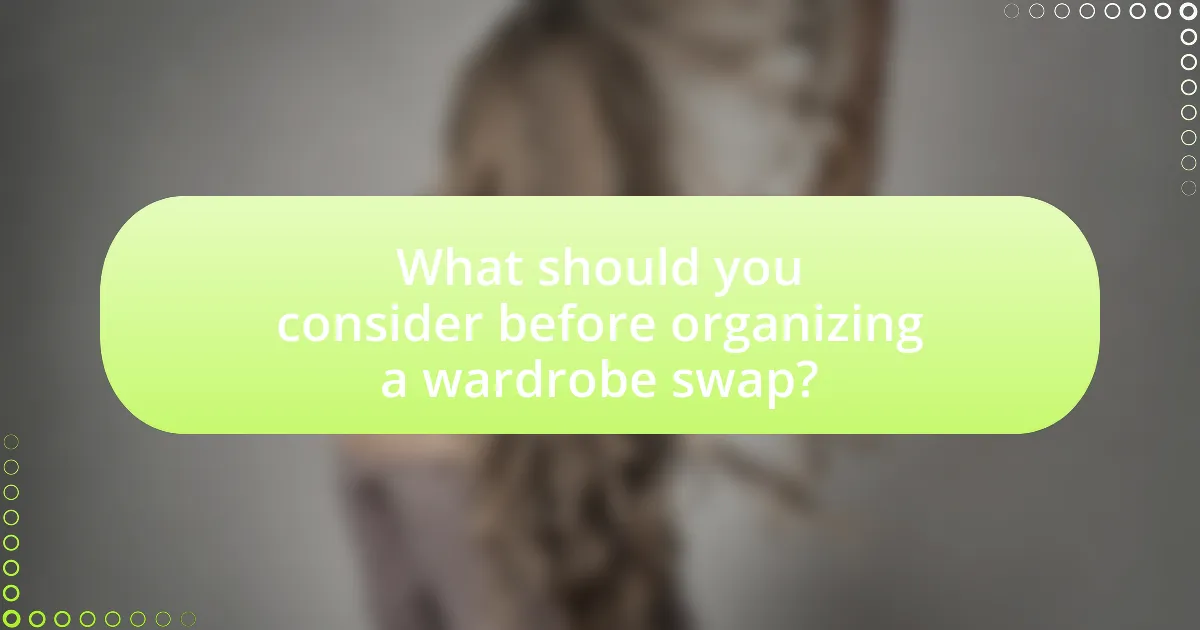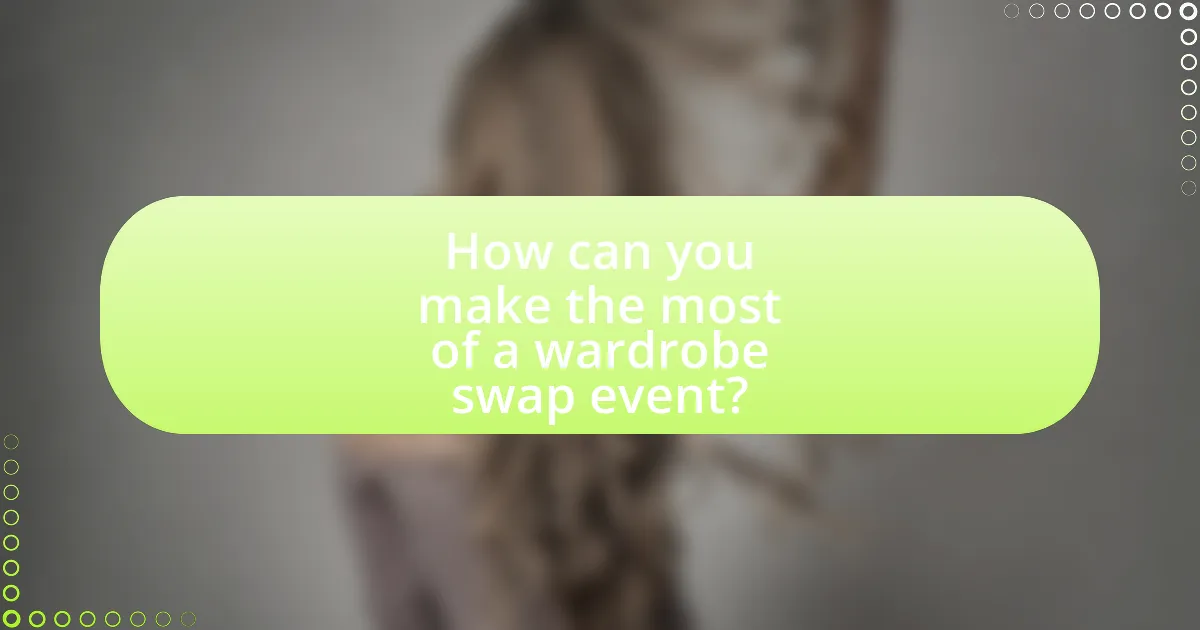Seasonal wardrobe swaps are events where individuals exchange gently used clothing items to refresh their wardrobes while promoting sustainable fashion practices. This article outlines how these swaps work, including the organization process, types of items typically exchanged, and the social and environmental benefits they provide. It also discusses best practices for successful swaps, such as assessing personal wardrobes, ensuring fair selection, and creating a welcoming atmosphere. Additionally, the article addresses common challenges participants may face and offers strategies for effective communication and conflict resolution during the exchange process.

What are Seasonal Wardrobe Swaps?
Seasonal wardrobe swaps are events where individuals exchange clothing items to refresh their wardrobes for the upcoming season. These swaps typically involve gathering friends or community members to bring gently used clothing that they no longer want, allowing participants to select new items from others’ contributions. This practice not only promotes sustainable fashion by reducing waste but also fosters social connections and provides an opportunity for individuals to update their style without spending money.
How do Seasonal Wardrobe Swaps work?
Seasonal wardrobe swaps involve gathering a group of friends to exchange clothing items that are no longer wanted or needed. Participants bring their gently used clothing to a designated location, where items are displayed for others to browse and select. This process not only refreshes individual wardrobes but also promotes sustainable fashion practices by reducing waste. Evidence of the effectiveness of wardrobe swaps can be seen in community events that report increased participation and satisfaction, highlighting the social and environmental benefits of such exchanges.
What items are typically exchanged during a wardrobe swap?
During a wardrobe swap, items typically exchanged include clothing, accessories, shoes, and sometimes bags. Participants often bring gently used or new items that they no longer wear, allowing others to refresh their wardrobe without spending money. This practice promotes sustainability and encourages sharing among friends, as it helps reduce waste and fosters community.
How is the swapping process organized?
The swapping process is organized by gathering participants, setting a date and location, and establishing guidelines for the types of items to be exchanged. Participants typically bring their unwanted clothing items, which are then sorted and displayed for others to browse. This organization ensures a smooth exchange, allowing individuals to select items they desire while giving away items they no longer need. The effectiveness of this process is supported by the growing popularity of clothing swaps, which promote sustainable fashion practices and community engagement.
Why are Seasonal Wardrobe Swaps beneficial?
Seasonal wardrobe swaps are beneficial because they promote sustainable fashion practices and reduce clothing waste. By exchanging clothes with friends, individuals can refresh their wardrobes without purchasing new items, thereby minimizing their environmental impact. Studies indicate that the fashion industry is responsible for a significant portion of global waste, with an estimated 92 million tons of textile waste generated annually. Engaging in wardrobe swaps not only fosters community and social connections but also encourages a more mindful approach to consumption, ultimately contributing to a circular economy in fashion.
What environmental benefits do wardrobe swaps provide?
Wardrobe swaps provide significant environmental benefits by reducing textile waste and minimizing the demand for new clothing production. By participating in wardrobe swaps, individuals extend the lifecycle of garments, which helps decrease the volume of clothing that ends up in landfills; in the United States alone, approximately 11.3 million tons of textile waste were generated in 2018. Additionally, wardrobe swaps contribute to lower carbon emissions associated with manufacturing and transporting new clothing, as the fashion industry is responsible for about 10% of global carbon emissions. Thus, wardrobe swaps promote sustainable consumption practices and support a circular economy in fashion.
How can wardrobe swaps enhance social connections?
Wardrobe swaps enhance social connections by fostering community engagement and collaboration among participants. When individuals come together to exchange clothing, they create opportunities for interaction, sharing personal stories, and building relationships based on mutual interests in fashion and sustainability. Research indicates that social activities, such as clothing swaps, can strengthen social ties and promote a sense of belonging, as evidenced by a study published in the Journal of Consumer Research, which found that shared experiences significantly enhance interpersonal connections.

What should you consider before organizing a wardrobe swap?
Before organizing a wardrobe swap, you should consider the preferences and sizes of participants to ensure a successful exchange. Understanding what each participant is looking for and what they can offer helps create a more satisfying experience. Additionally, setting clear guidelines regarding the condition of items, such as only accepting gently used clothing, can maintain quality and satisfaction among participants. Research indicates that successful clothing swaps often involve clear communication and organization, which enhances the overall experience and encourages participation.
How do you choose the right friends for a wardrobe swap?
To choose the right friends for a wardrobe swap, select individuals who have similar styles and sizes to ensure compatibility. Friends with a shared fashion sense will likely appreciate and wear the items you offer, while those with similar body types will find the clothing more fitting. Additionally, consider friends who are responsible and respectful of your belongings, as this fosters trust and ensures that the items are returned in good condition. Research indicates that successful clothing swaps often occur among friends who communicate openly about their preferences and expectations, enhancing the overall experience.
What factors should you consider regarding your friends’ styles?
When considering your friends’ styles for seasonal wardrobe swaps, evaluate their personal preferences, body types, and lifestyle needs. Personal preferences dictate what styles they feel comfortable and confident in, while body types influence how certain clothing fits and flatters them. Additionally, understanding their lifestyle needs, such as professional attire versus casual wear, ensures that the swapped items will be practical and useful. These factors are crucial for a successful and enjoyable clothing exchange, as they help maintain the integrity of each friend’s unique style while fostering a collaborative and supportive environment.
How can you ensure everyone has a fair selection?
To ensure everyone has a fair selection during a seasonal wardrobe swap, establish clear guidelines for participation and item selection. This can include setting a limit on the number of items each participant can bring and ensuring that all items are in good condition. Additionally, implementing a rotation system for selecting items can help maintain fairness; for example, participants can draw numbers to determine the order of selection. Research shows that structured processes in group activities lead to higher satisfaction and perceived fairness among participants.
What preparations are necessary for a successful wardrobe swap?
To ensure a successful wardrobe swap, participants should first declutter their closets by selecting items they no longer wear or need, ensuring these pieces are clean and in good condition. This preparation step is crucial as it allows for a focused exchange of quality items, enhancing the overall experience for all involved. Additionally, organizing the swap event by setting a date, location, and guidelines for participation fosters a structured environment, which can lead to a more enjoyable and efficient process. Research indicates that well-organized events increase participant satisfaction and engagement, making the swap more effective.
How do you assess your own wardrobe before the swap?
To assess your own wardrobe before the swap, start by evaluating each item for its condition, fit, and frequency of wear. This process involves checking for any signs of damage, ensuring that the clothing fits well, and determining how often you actually wear each piece. Research indicates that individuals typically wear only 20% of their wardrobe regularly, highlighting the importance of this assessment to identify items that can be swapped. By categorizing clothes into keep, swap, or discard piles based on these criteria, you can effectively streamline your wardrobe and make informed decisions about what to bring to the swap.
What items should be prioritized for swapping?
Clothing items that should be prioritized for swapping include seasonal apparel such as coats, jackets, and boots, as well as accessories like scarves and hats. These items are often expensive and are used less frequently, making them ideal for sharing among friends. Additionally, high-quality or trendy pieces that may no longer fit or suit personal style can be valuable for swapping, as they provide variety without the need for new purchases. Prioritizing these items maximizes the benefits of a wardrobe swap, allowing participants to refresh their collections while minimizing waste and cost.

How can you make the most of a wardrobe swap event?
To make the most of a wardrobe swap event, arrive with a curated selection of high-quality, gently used clothing items that you no longer wear. This approach ensures that you contribute valuable pieces to the swap, increasing the likelihood of finding desirable items in return. Additionally, engaging with other participants by discussing styles and preferences can enhance the experience, fostering a sense of community and collaboration. Research indicates that clothing swaps promote sustainable fashion practices, as they encourage recycling and reduce waste, making them beneficial for both individuals and the environment.
What strategies can enhance the swapping experience?
To enhance the swapping experience during seasonal wardrobe swaps, participants should establish clear guidelines and expectations prior to the event. This includes setting a specific date, determining the number of items each person can bring, and agreeing on the condition of the clothing to be swapped. Research indicates that structured events lead to higher satisfaction rates among participants, as they feel more organized and engaged. Additionally, creating a welcoming environment with adequate space for displaying items can facilitate better interaction and decision-making, ultimately improving the overall experience.
How can you create a welcoming atmosphere for participants?
To create a welcoming atmosphere for participants in a seasonal wardrobe swap, ensure the space is inviting and comfortable. Arrange seating in a circle to promote interaction and provide ample lighting to enhance visibility. Incorporate elements like soft music and refreshments to create a relaxed environment. Research indicates that a comfortable setting can significantly improve social interactions and participant satisfaction, as highlighted in studies on event planning and social gatherings.
What activities can be included to make the event fun?
To make the event fun, activities such as a fashion show, DIY customization stations, and themed refreshments can be included. A fashion show allows participants to showcase their swapped outfits, creating an engaging atmosphere. DIY customization stations enable attendees to personalize their new clothing items, fostering creativity and interaction. Themed refreshments, such as seasonal snacks and drinks, enhance the overall experience and encourage socializing among participants. These activities not only promote engagement but also create a lively and enjoyable environment for everyone involved.
What are some common challenges during wardrobe swaps?
Common challenges during wardrobe swaps include mismatched sizes, differing personal styles, and emotional attachments to clothing. Mismatched sizes can lead to frustration when items do not fit as expected, making it difficult for participants to find suitable pieces. Differing personal styles may result in items being unwanted or unused, as individuals may not appreciate each other’s fashion choices. Emotional attachments to clothing can complicate the process, as participants may struggle to part with items they have sentimental value for, hindering the swap’s effectiveness. These challenges can impact the overall success and enjoyment of wardrobe swaps.
How can you handle disagreements over items?
To handle disagreements over items during a seasonal wardrobe swap, communicate openly with the involved parties to express concerns and preferences. Clear communication helps clarify misunderstandings and allows each person to voice their opinions regarding the items in question. For instance, if one person feels strongly about a specific piece of clothing, discussing its value and significance can lead to a compromise, such as a temporary exchange or a rotation system. Research indicates that effective communication in conflict resolution can lead to more satisfactory outcomes, as noted in studies on negotiation strategies.
What should you do if items are not in good condition?
If items are not in good condition, you should assess their usability and determine whether they can be repaired or should be discarded. For example, if clothing has minor damages like loose threads or small stains, consider mending or cleaning them before trading. However, if items are heavily worn or damaged beyond repair, it is best to recycle or donate them responsibly, as trading unusable items can diminish the overall quality of the wardrobe swap.
What are the best practices for a successful wardrobe swap?
The best practices for a successful wardrobe swap include organizing the event with clear guidelines, ensuring participants bring high-quality, clean items, and creating a welcoming atmosphere. Organizing the swap involves setting a date, location, and rules regarding the number of items each participant can bring. High-quality items are essential as they increase the likelihood of successful exchanges; items should be in good condition and freshly laundered. A welcoming atmosphere encourages participation and enjoyment, which can be achieved through refreshments and a friendly environment. These practices enhance the overall experience and effectiveness of the wardrobe swap.
How can you ensure a smooth exchange process?
To ensure a smooth exchange process during seasonal wardrobe swaps, establish clear communication among participants regarding expectations and item conditions. This clarity helps prevent misunderstandings about the quality and suitability of the items being exchanged. Additionally, organizing the swap in a designated space that allows for easy browsing and sorting of clothes can enhance the experience. According to a study by the Journal of Consumer Research, effective communication and organization significantly improve satisfaction in peer-to-peer exchanges.
What follow-up actions should be taken after the swap?
After the swap, participants should organize and clean the swapped items to ensure they are in good condition for future use. This includes checking for any damages, washing or dry cleaning the clothes, and returning any items that do not fit or are unwanted. Additionally, participants should communicate with each other to express gratitude and provide feedback on the swap experience, which can help improve future exchanges. Keeping a record of items swapped can also be beneficial for tracking what was received and what may be needed in the future.
